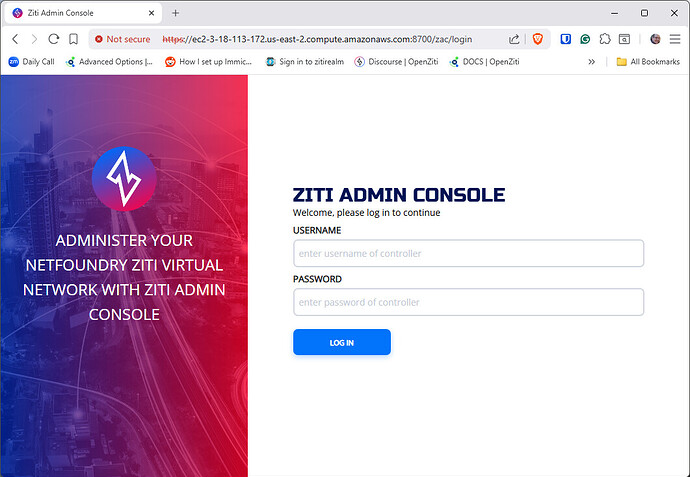Thank you for your patience with me!
So for the first test setup I used the following env file and hosts file:
GNU nano 8.4 .env *
# OpenZiti Variables
ZITI_IMAGE=openziti/quickstart
ZITI_VERSION=latest
the user and password to use
Leave password blank to have a unique value generated or set the password explicitly
ZITI_USER=admin
ZITI_PWD=password
ZITI_INTERFACE=0.0.0.0
controller name, address/port information
ZITI_CTRL_EDGE_ADVERTISED_ADDRESS=openziti.hostname.tld
ZITI_CTRL_ADVERTISED_ADDRESS=openziti.hostname.tld
#ZITI_CTRL_EDGE_IP_OVERRIDE=10.10.10.10
ZITI_CTRL_ADVERTISED_PORT=8700
ZITI_CTRL_EDGE_ADVERTISED_PORT=8700
The duration of the enrollment period (in minutes), default if not set. shown - 7days
ZITI_EDGE_IDENTITY_ENROLLMENT_DURATION=110080
ZITI_ROUTER_ENROLLMENT_DURATION=110080
ZITI_ROUTER_LISTENER_BIND_PORT=8701
/etc/hosts on VM contains
192.168.1.250 openziti.hostname.tld
Used direct copy of docker-compose.yml example.
on attempt to run with ‘docker compose up’ it keeps giving these back:
ziti-edge-router-1 | waiting for ``https://openziti.hostname.tld:8700
ziti-controller-init-container-1 | waiting for ``https://openziti.hostname.tld:8700
sudo ss -lpn shows:
tcp LISTEN 0 4096 0.0.0.0:10080 0.0.0.0:* users:(("docker-proxy",pid=1423,fd=7))
tcp LISTEN 0 4096 0.0.0.0:8700 0.0.0.0:* users:(("docker-proxy",pid=1262,fd=7))
tcp LISTEN 0 4096 0.0.0.0:3022 0.0.0.0:* users:(("docker-proxy",pid=1415,fd=7))
So services are running, I guess it’s not accepting the certificate?
curl https://openziti.hostname.tld:8700 shows:
curl: (60) SSL certificate problem: self-signed certificate in certificate chain
More details here:
curl failed to verify the legitimacy of the server and therefore could not
establish a secure connection to it. To learn more about this situation and
how to fix it, please visit the webpage mentioned above.
curl https://openziti.hostname.tld:8700 –insecure shows:
{"data":{"apiVersions":{"edge":{"v1":{"apiBaseUrls":["``https://openziti.hostname.tld:8700/edge/client/v1"],"path":"/edge/client/v1"}},"edge-client":{"v1":{"apiBaseUrls":["https://openziti.hostname.tld:8700/edge/client/v1"],"path":"/edge/client/v1"}},"edge-management":{"v1":{"apiBaseUrls":["https://openziti.hostname.tld:8700/edge/management/v1"],"path":"/edge/management/v1"}},"edge-oidc":{"v1":{"apiBaseUrls":["https://openziti.hostname.tld:8700/oidc"],"path":"/oidc"}}},"buildDate":"2025-10-16T15:35:19Z","capabilities":["OIDC_AUTH"],"revision":"1bd146994aa6","runtimeVersion":"go1.24.7","version":"v1.7.0"},"meta``":{}}
Could I use the pem and key from my wildcard certs from nginx webserver?
After the zac step and restarting the controller did not come up again if I check with: sudo ss -lpn
docker compose up log showed these lines, seems to break controller start:
ziti-controller-1 | [ 0.309] FATAL ziti/controller/subcmd.NewEdgeInitializeCmd.func2: already initialized: Ziti Edge default admin already defined
ziti-controller-1 | --- There was an error while initializing the controller ---


